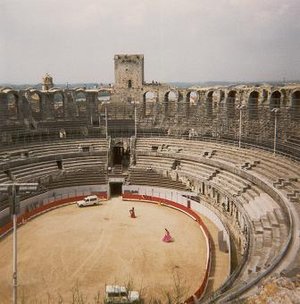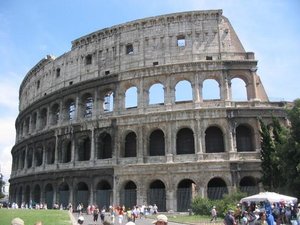Amphitheatre
|
|
The name amphitheatre (alternatively amphitheater) is given to a public building of the Classical period (being particularly associated with ancient Rome) which was used for spectator sports, games and displays.
Apart from function, the important outward distinction between an amphitheatre and a theatre is that an amphitheatre is round or oval in shape (whereas a theatre is semi-circular). However, an amphitheatre differs from a circus, which was used for racing and looked more like a very long, narrow horse shoe.
The best-known amphitheatre in the world is the Roman Colosseum, which is more correctly termed the Flavian amphitheatre (Amphitheatrum Flavium), after the Flavian dynasty who had it built.
| Contents |
Catalogue of Roman amphitheatres
The remains of some 75 amphitheatres have been located in widely scattered areas of the Roman Empire. These locations include:
Albania
Croatia
Cyprus
England

France
- Arelate (modern Arles)
- Grand
- Lugdunum (modern Lyon)
- Nemausus (modern Ns)
- Lutetia (modern Paris): Ar讥s de Lut裥
- Mediolanum Santonum (modern Saintes)
Germany
Greece
The Netherlands
- Nijmegen (No longer extant, but traced out in the street paving of the present-day Rembrandstraat (http://www.viamichelin.com/viamichelin/gbr/dyn/controller/mapPerformPage?strAddress=rembrandtstraat&strLocation=nijmegen&strCP=&strCountry=000000285&strStartAddress=&strStartCity=&strStartCP=&strStartCityCountry=000001138&strDestAddress=&strDestCity=&strDestCP=&strDestCityCountry=000001138) with a few bits of its foundations still visible)
Italy
- Aosta
- Ariminum
- Arretium
- Assisium
- Capua
- Carsulae
- Hispellum
- Mediolanum
- Mevania
- Nola
- Ocriculum
- Pompeii
- Puteoli
- Rome (2 amphitheatres: the Colosseum, the Amphitheatrum Castrense)
- Rusellae
- Spoletium
- Urbs Salvia
- Verona: Verona Arena
Libya
Spain
Switzerland
Tunisia
Wales
Hollywood_Bowl.jpg
Contemporary amphitheatres
In contemporary use, the term amphitheatre is often used to refer to semi-circular, acoustically vibrant performances spaces, particularly those which are located outdoors. These often include standing structures, sometimes curved or "bowl" shaped, both behind the stage and behind the audience, creating an area which echoes or amplifies sound, making the amphitheatre ideal for musical or theatrical performances.
A natural amphitheatre is a performance space located in a spot where a steep mountain or a particular rock formation naturally amplifies or echoes sound, making it ideal for musical and theatrical performances. The term amphitheatre can also be used to describe naturally occurring formations which would be ideal for this purpose, even if no theatre has been constructed there.
Notable modern amphitheatres include the Universal Amphitheatre and the Hollywood Bowl. Notable natural amphitheatres include Echo Rock, New Mexico, Cedar Breaks National Monument and Red Rocks, Colorado.
See also:
External links
- article "Amphitheatrum" (http://penelope.uchicago.edu/Thayer/E/Roman/Texts/secondary/SMIGRA*/Amphitheatrum.html) (Smith's Dictionary of Greek and Roman Antiquities)
- Caerleon amphitheatre (http://www.caerleon.net/history/amphexcav/)
- Chester amphitheatre (http://www.bwpics.co.uk/amphitheatre.html)
- Pula amphitheatre (http://www.academia-cravatica.hr/en/arena.html)
- Rome: Colosseum at LacusCurtius (http://penelope.uchicago.edu/Thayer/E/Gazetteer/Places/Europe/Italy/Lazio/Roma/Rome/Colosseum/home.html) with Platner article
- Rome: Amphitheatrum Castrense (http://penelope.uchicago.edu/Thayer/E/Gazetteer/Places/Europe/Italy/Lazio/Roma/Rome/walls/Aurelian/Amphitheatrum_Castrense/home.html)

